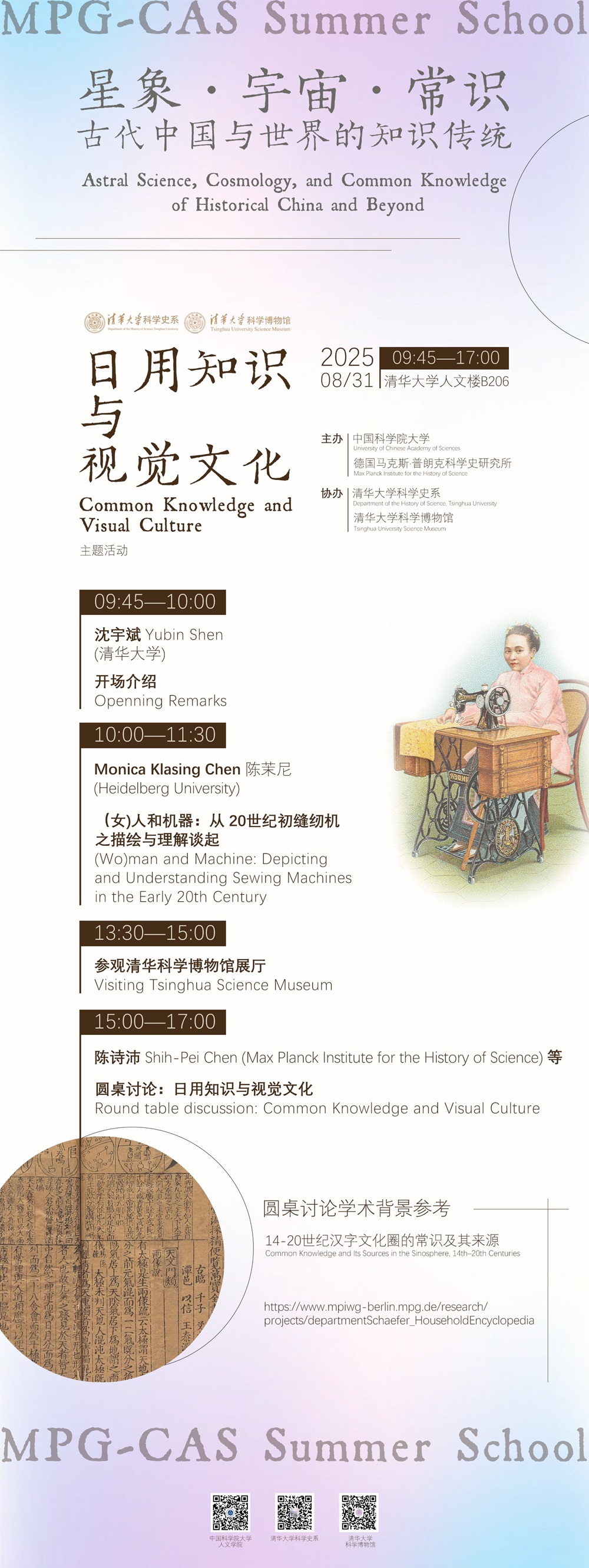
由中国科学院大学与德国马克斯·普朗克科学史研究所联合主办、中国科学院大学人文学院承办的暑期学校“星象·宇宙·常识:古代中国与世界的知识传统”特别安排“日用知识与视觉文化”主题学术活动,通过专题讲座、清华大学科学博物馆实地考察与圆桌研讨,为学员提供结合物质文化与知识史研究的交流平台。本次活动由清华大学科学史系和清华大学科学博物馆支持。
This summer school (Astral Science, Cosmology, and Common Knowledge of Historical China and Beyond) features a special academic program on the theme of "Everyday Knowledge and Visual Culture." Through expert lectures, field visits to the Tsinghua University Science Museum, and roundtable discussions, it provides participants with a collaborative platform integrating material culture and the history of knowledge. This program is supported by the Department of History of Science at Tsinghua University and the Tsinghua University Science Museum.
09:45—10:00
开场介绍 Openning Remarks
沈宇斌 Yubin Shen (清华大学)
清华大学科学史系
清华大学科学史系成立于2017年,在西方科学技术史、中国科学技术史、科学哲学与技术哲学、科学传播学与科学博物馆学四个方向推进清华科学技术史学科建设。科学史系主持清华大学科学博物馆的内容建设和日常管理,并且通过科学博物馆平台,面向公众传播科学文化。
The Department of the History of Science at Tsinghua University was established in 2017 to advance the discipline's development in four key areas: the history of Western science and technology, the history of Chinese science and technology, the philosophy of science and technology, and science communication and museology. The department oversees the content development and daily operations of the Tsinghua University Science Museum, leveraging this platform to promote scientific culture among the public.10:00—11:30
10:00—11:30
(女)人和机器:从 20世纪初缝纫机之描绘与理解谈起
(Wo)man and Machine: Depicting and Understanding Sewing Machines in the Early 20th Century
Monica Klasing Chen 陈茉尼 (Heidelberg University)
讲座简介
新技术往往在吸引人类的同时,也令人焦虑不安。19世纪末,当机械装置和各种机器的图像首次在中国出版时,对这些机器的反应也看法不一。这些奇妙的发明究竟是利人还是害人?劳动机械化究竟会造福民族,还是会破坏社会秩序?本场讲座中,我们将透过大众媒体(例如19世纪末20世纪初的插图报刊、杂志和日用类书)的视角,探讨机械装置在中国的早期接受情况。讲座将重点探讨机器与人对休闲、社会、生产力和现代性的观念转变的关系,以及机器如何影响中国读者对其他国家的想象。尽管明清宫廷早已对耶稣会传教士带来的钟表和自动机表现出浓厚的兴趣,但真正引起普通读者兴趣的是农业和交通机器,以及机器人和缝纫机。机器一旦融入人们的日常生活,便会影响人类的活动和工作的方式,甚至影响他们对自己的身体和运动的理解。为了讨论机器如何塑造人类行为,我们将深入探讨缝纫机引入中国家庭的情况和缝纫机如何成为女性教育的一工具。我们将考察用户手册——一种面向普通读者的新型文本体裁——如何以通俗易懂的语言和插图描述机器的保养和维护方法,从而引领新的行为模式。
New technologies often captivate humans and make them anxious at the same time. When images of mechanical devices and different types of machines were first published in China in the late 19th century, the responses to the machines were also mixed. Would the marvellous inventions benefit or harm humans? Would the mechanization of labour benefit the Chinese nation, or would they destablize social order?In this lecture we will look at the early reception of mechanical devices in China through the lens of popular media, such as illustrated newspapers, magazines and encyclopedias in the late 19th and early 20th century. The lecture will highlight how machines could be connected to changing ideas about leisure, society, productivity and modernity, and how they populated the imaginary of the Chinese readers about other nations. Even though the Ming and Qing courts had already shown considerable interest in the clocks and automata that had been presented by Jesuit missionaries, it was machines for agriculture and transportation, as well as robots and sewing machines, that stirred the interest of common readers. Once machines were integrated in people’s daily lives, these affected the way humans structured their activities and work, and even how they understood the human body and movement. To discuss how machines can shape human behaviour, we will take a closer look at the introduction of the sewing machine in the Chinese home, and the popularization of machine-sewing as a part of women’s education. We will also consider how user manuals, a new textual genre for the common reader, described ways to care for and conduct maintenance on machines in accessible language and with illustrations, dictating new forms of behaviour.
陈茉尼博士是海德堡大学东亚艺术系中国艺术史助理教授。曾在圣保罗大学(巴西)学习美术和艺术教育,在海德堡大学(德国)学习东亚艺术史和汉学,并在莱顿大学(荷兰)获得博士学位。她的博士论文「可记忆的艺术:明清绘画和书法的记忆法」探讨记忆法在实用知识传播中的作用。她目前的研究重点是19世紀末20世紀初习惯养成的过程,关注物质文化含义的变化、废物利用之实践和家务劳动机械化的新习惯。
Dr. Monica Klasing Chen is Assistant Professor for Chinese Art History at Heidelberg University. She studied Fine Arts and Art Education at São Paulo University, East Asian Art History and Sinology at Heidelberg University and received her PhD from Leiden University. Her dissertation, “Memorable Arts: The Mnemonics of Painting and Calligraphy in Late Imperial China,” addresses the role of mnemonics in the transmission of practical knowledge. Her habilitation project tackles the formation of habits in the late 19th and early 20th century through an analysis of normative texts,investigating changing meanings of material culture, practices of recycling, and new habits that take the mechanization of household labor into account.
13:30—15:00
参观清华科学博物馆展厅
Visiting Tsinghua Science Museum
清华大学科学博物馆
正在建设中的清华大学科学博物馆,是中国第一家综合类收藏型研究性科学博物馆。它将以科技文物和高科技互动展品相结合的展陈方式,再现人类科技史上伟大的科学发现和技术发明,再现清华理工科在中国近现代科技史上的辉煌成就,成为促进科学传播、激励科技创新的清华新景观。
The Tsinghua University Science Museum is a dynamic space that brings to life the groundbreaking scientific discoveries and technological innovations that have shaped human history. As China’s first comprehensive university museum dedicated to scientific collections, it not only showcases significant scientific artifacts but also highlights the remarkable contributions of Tsinghua University’s researchers in science and engineering.15:00—17:00
15:00—17:00
圆桌讨论:日用知识与视觉文化
Round table discussion: Common Knowledge and Visual Culture
1.沈宇斌 (清华大学)
2. 孙萌萌 (中国科学院大学)
3.陈诗沛 (Max Planck Institute for the History of Science)
4. 薛凤 Dagmar Schäfer (Max Planck Institute for the History of Science)
5.Marta Hanson (Friedrich-Alexander-Universität Erlangen-Nürnberg)
6.Joan Judge (York University)
7.Monica Klasing Chen (Heidelberg University)
8. Cynthia Joanne Brokaw (Brown University)
9.张鹤天 (厦门大学)
10.杜新豪 (中科院自然科学史研究所)
14-20世纪汉字文化圈的常识及其来源
Common Knowledge and Its Sources in the Sinosphere, 14th–20th Centuries
类书在中国古代知识的编纂与界定中占据着重要的基础地位。自三世纪以来,这一文类便体现了汉字文化圈对百科全书式知识的组织方式:将知识按照“类”加以分类整理,以供查阅使用。除了那些由皇室或士大夫精英主导的大型类书项目,用以收集上层社会的学术知识之外,类书后来也发展出一个重要的分支——日用类书,系统地汇集了面向普通大众的“日常”或“通俗”知识,用于日常生活实践。本项目聚焦日用类书的编纂与传播,以此为切入点,探讨在帝制晚期至民国时期社会知识重心由皇权精英知识转向日常实用知识的过程中,通俗知识的选取与整理机制。我们运用数字人文方法,识别不同文类中相似的文字与图像内容,从而追溯这些百科类书中文图素材的来源。通过厘清编书者如何采集与加工其内容,我们能够揭示其编辑过程与背后的逻辑体系,并进一步理解类书这一文类的性质,以及晚清与民国时期通俗知识的生成方式。本项目由陈诗沛博士主持。
Category books (leishu 類書) are an important cornerstone for the compilation and delineation of knowledge in Imperial China. Since the third century, this genre has encapsulated the Chinese approach to encyclopedic knowledge of the sinosphere: it orders knowledge into categories (lei 類) for further reference. Aside from the prominent elite and imperial projects that produced a large compilation of elite knowledge, leishu later on proliferated into a branch called household (or daily-use) encyclopedia (riyong leishu 日用類書), which systematically collected "lowbrow" knowledge for the general public's everyday experience.
This project traces the production and circulation of common knowledge, starting with the household encyclopedia, to understand the selection and compilation process of such knowledge when the intellectual focus of the society shifted from imperial elite knowledge to daily-use knowledge in late imperial and Republican China. We employ digital methods that identify similar text passages and illustrations across genres in order to trace the origins of textual and visual contents collected in these encyclopedia. By knowing where encyclopedia compilers obtained their contents from, it would reveal the editing processes and the logics behind, which in turn inform us about the nature of this genre and common knowledge emerged in late imperial and Republican China.
This working group is directed by Dr. Shih-Pei Chen.
学术背景参考:
https://www.mpiwg-berlin.mpg.de/research/projects/departmentSchaefer_HouseholdEncyclopedia


